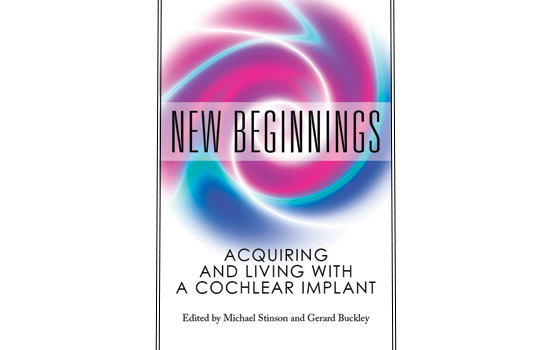Cochlear implant recipients share stories in book
Personal stories are shared from cochlear implant recipients
A medical device that has allowed thousands of deaf individuals worldwide the opportunity to hear—sometimes for the first time and well enough to talk on the telephone—is the focus of 15 personal experiences in a new book published by RIT Press at Rochester Institute of Technology.
New Beginnings, Acquiring and Living with a Cochlear Implant is a compilation of stories written by deaf or hard-of-hearing individuals who have had cochlear implants. Their personal stories will give readers insight into the struggles and challenges they endured through the process as well as the delights and disappointments they faced after surgery.
The book was edited by Michael Stinson, a research faculty member at RIT’s National Technical Institute for the Deaf, and NTID President Gerry Buckley. Both Stinson and Buckley have cochlear implants and each has been involved in education for deaf and hard-of-hearing students for more than 30 years.
“When Gerry and I were considering getting our implants, we could find no resource that described the possible outcomes we might experience,” Stinson said. “We decided to create the resource by bringing together diverse cochlear implant users to write about their experiences so that others considering an implant would have a better idea of what to expect.”
Buckley also hopes the book will help others going through the same process.
“This book is designed to provide deaf and hard-of-hearing individuals and their families with additional insights into the diverse experiences of individuals who are cochlear implant users,” Buckley said. “It is our desire to see this book of experience serve as an information source for individuals who are considering this option in their lives.”
Cochlear implants involve a surgical process that enables some individuals to hear sounds via an implanted electronic device that converts sounds to electrical signals that directly stimulate peripheral parts of the auditory nerve.
Early attempts with using cochlear implants weren’t always successful, but technological advancements now enable some implant recipients to hear more frequencies. What used to involve an overnight hospital stay for implant patients is now typically an outpatient procedure.
There are some who question the decision of hearing parents who get implants for their young, deaf children, saying that it would deprive them of knowing about deaf culture and becoming part of it as their identity. In 2000, the National Association of the Deaf took a position that views cochlear implants as a technological aid that could be used in some instances, much like hearing aids, while affirming that it is also important for deaf children who receive implants to become aware of deaf culture.
In 2002, there were an estimated 70,000 cochlear implant users worldwide. That number tripled by 2010. This year, a record 360 students at RIT/NTID have cochlear implants. That’s more than 28 percent of the deaf and hard-of-hearing students who attend RIT/NTID.
Brenda Battat, past executive director of the Hearing Loss Association of America, said the book is a “must read” for anyone interested in this issue.
Nancy Bloch, former CEO of the National Association of the Deaf, noted that 13 of the 15 contributors to this book are people who use sign language. Their perspectives “would be of benefit to the decision-making efforts of deaf individuals considering single or bilateral implants,” she said.
New Beginnings is available in softcover for $17.99 through RIT Press or by calling RIT Press at 585-475-6766.














